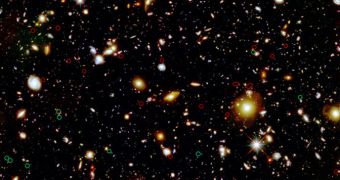In order to discover the oldest and most distant galaxies in the Universe, astronomers are using galaxies and clusters as massive gravitational lenses to boost telescopes' observing power. But doing so may actually harm the end result of the studies, a new report shows.
According to the document, using this particular observations technique could change the actual number of observed galaxies by up to a factor of 10. This could have significant implications for experts seeking to study the earliest days of the Universe.
The reason why the most advanced space telescopes are currently being built is because they are supposed to look as far back in the history of the Cosmos as the time when the first light appeared.
After the Big Bang, the Universe was a rapidly-expanding mass of amorphous hydrogen gas, wherein no light existed. It was only when the first stars appeared that photons began being produced.
Astronomers are interesting in learning more about this moment, such as for example when conditions became right for nuclei of gravitational pull to form within the hydrogen mass. Around these nuclei, more and more hydrogen gathered, until conditions were ripped for stars to appear.
Experts hope to use very advanced space telescopes to look back in time and see these first galaxies directly. But this objective is not easy to achieve, considering that numerous interferences that exist between Earth and the most distant galaxies ever.
The light that those objects emit is very distant and dim. The Universe is more than 13. 7 billion years old at this point, and telescopes need to look back more than 13 billion years in order to find the first light emitted by the earliest stars.
They cannot do so directly, and this is why gravitational lenses are used. Galaxies are so heavy, that they bend space-time around them, which in turn creates a lens-like effect if we want to observe bodies that are located behind them.
Experts calculated in the past that the measurements of distant galaxies is distorted by 0.5 percent through this technique, but the new report shows that few astronomers account for “magnification bias” in their studies.
This effect may cause a distant galaxy to appear a lot brighter than it actually is. “Gravitational lensing is magnifying all galaxies lying behind a gravitational lens, and this happens much more often for the most distant galaxies,” explains Stuart Wyithe.
The expert, who is the lead author of a new study detailing the findings, holds an appointment as an astronomer at the University of Melbourne in Australia, Space reports.
Details of the new research were published in the January 13 issue of the esteemed scientific journal Nature.

 14 DAY TRIAL //
14 DAY TRIAL //